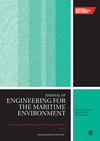考虑到设计和施工特点的玻璃纤维增强聚合物(GFRP)船体板超声波无损检测方法
IF 1.5
4区 工程技术
Q3 ENGINEERING, MARINE
Proceedings of the Institution of Mechanical Engineers, Part M: Journal of Engineering for the Maritime Environment
Pub Date : 2024-04-16
DOI:10.1177/14750902241245539
引用次数: 0
摘要
玻璃纤维增强聚合物(GFRP)船体板的设计和结构特征,包括玻璃纤维重量分数(Gc)、单层层数、织物组合和制造质量,会影响超声波传播特性,如超声波速度和衰减,从而影响超声波无损检测结果的准确性。因此,本研究提出了一种利用统计方法降低 GFRP 船体板超声波测试误差的方法。考虑到一般设计施工特点,采用手糊法制备了 Gc 约为 30-50wt%、厚度约为 5-20 mm、不同织物组合的 GFRP 试样。此外,考虑到 GFRP 船体的设计结构特征,如 Gc 和船体板单层层数,通过多元线性回归法提出了超声波检测的超声波速度决策方法。结果表明,与现有的超声波检测方法相比,仅考虑 Gc 对超声波速度的影响,所提出的方法可将厚度测量误差从约 20%-30% 降低到 1%-2%,这表明所提出的检测方法适合实际应用。本文章由计算机程序翻译,如有差异,请以英文原文为准。
Ultrasonic non-destructive inspection method for glass fibre reinforcement polymer (GFRP) hull plates considering design and construction characteristics
The design and construction characteristics, including glass fibre weight fraction ( Gc), number of single-ply layers, fabric combination, and fabrication quality, of glass fibre reinforcement polymer (GFRP) hull plates affect ultrasound propagation characteristics, such as ultrasonic velocity and attenuation, thereby influencing the accuracy of ultrasonic non-destructive test results. Therefore, this study is to propose a method to decrease the ultrasonic test errors of GFRP hull plate by using statistical method. The GFRP specimens with Gc of approximately 30–50 wt%, thicknesses of approximately 5–20 mm, and different fabric combinations were prepared using the hand lay-up method, considering the general design–construction characteristics. Further, an ultrasonic velocity decision method for ultrasonic inspection was proposed considering the GFRP hull design-construction characteristics, such as Gc and number of single-ply layers of hull plate by multiple linear regression method. The results show that the proposed method can reduce the thickness measurement error from approximately 20%–30% to 1%–2%, compared to an existing ultrasonic inspection method, only considering the Gc effect on ultrasonic velocity, which indicates that the proposed test method is suitable for practical applications.
求助全文
通过发布文献求助,成功后即可免费获取论文全文。
去求助
来源期刊

CiteScore
3.90
自引率
11.10%
发文量
77
审稿时长
>12 weeks
期刊介绍:
The Journal of Engineering for the Maritime Environment is concerned with the design, production and operation of engineering artefacts for the maritime environment. The journal straddles the traditional boundaries of naval architecture, marine engineering, offshore/ocean engineering, coastal engineering and port engineering.
 求助内容:
求助内容: 应助结果提醒方式:
应助结果提醒方式:


